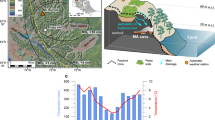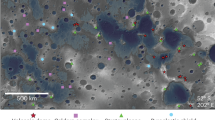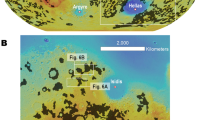Abstract
The relative rates and importance of impact cratering, volcanism, erosion, and the deposition of sediments to the early geological history of Mars are poorly known. That history is recorded in the upper crust of the planet, which is best exposed along the 4,000-km-long canyon system called Valles Marineris. Previous studies of the stratigraphy of this region have assumed that it consists of megabreccia and fractured bedrock resulting from impacts, overlain by or interbedded with relatively thin layers of lava, and with the layering restricted to the uppermost level of the crust1,2,3,4,5,6. Here we report new high-resolution images that reveal ubiquitous horizontal layering to depths of at least 8 km in the canyons. Megabreccia should be only coarsely layered and fractured bedrock should be unlayered, so these observations indicate that volcanic or sedimentary processes were much more important in early martian history than previously believed. Morphological and compositional data suggest that the layers were formed mainly by volcanic flood lavas. Mars was therefore probably very volcanically active during at least the first billion years and after the period when the heaviest impact bombardment had ended.
This is a preview of subscription content, access via your institution
Access options
Subscribe to this journal
Receive 51 print issues and online access
$199.00 per year
only $3.90 per issue
Buy this article
- Purchase on Springer Link
- Instant access to full article PDF
Prices may be subject to local taxes which are calculated during checkout



Similar content being viewed by others
References
Lucchitta, B. K. et al. in Mars (eds Kieffer, H. H., Jakosky, B. M., Snyder, C. M. & Matthews, M. S.) 453–492 (Univ. Arizona Press, Tucson, (1992)).
Tanaka, K. L., Scott, D. H. & Greeley, R. in Mars (eds Kieffer, H. H., Jakosky, B. M., Snyder, C. M. & Matthews, M. S.) 345–382 (Univ. Arizona Press, Tucson, (1992)).
Clifford, S. M. Amodel for the hydrologic and climatic behavior of water on Mars. J. Geophys. Res. 98, 10973–11016 (1993).
Tanaka, K. L. & Golombek, M. P. Martian tension fractures and the formation of graben and collapse features at Valles Marineris. Proc. Lunar Planet. Sci. Conf. 19, 383–396 (1989).
Davis, P. A. & Golombek, M. P. Discontinuities in the shallow Martian crust at Lunae, Syria, and Sinai Plana. J. Geophys. Res. 95, 14231–14248 (1990).
Zuber, M. T. & Aist, L. L. The shallow structure of the Martian lithosphere in the vicinity of the ridged plains. J. Geophys. Res. 95, 14215–14230 (1990).
Malin, M. C. et al. Mars Observer Camera. J. Geophys. Res. 97, 7699–7718 (1992).
Malin, M. C. et al. Early views of the Martian surface from the Mars Orbital Camera of Mars Global Surveyor. Science 279, 1681–1685 (1998).
Albee, A. L., Palluconi, F. D. & Arvidson, R. E. Mars Global Surveyor mission: Overview and status. Science 279, 1671–1672 (1998).
Lucchitta, B. K. Morphology of chasma walls, Mars. J. Res. US Geol. Surv. 6, 651–662 (1978).
Geissler, P. E., Singer, R. B. & Lucchitta, B. K. Dark materials in Valles Marineris: Indications of the style of volcanism and magmatism on Mars. J. Geophys. Res. 95, 14399–14413 (1990).
Scott, D. H. & Tanaka, K. L. Geologic Map of the Western Equatorial Region of Mars, Scale 1:15,000,000 (Misc. Inv. Ser. Map I-1802-A, US Geol. Surv., Denver, (1986)).
Witbeck, N. E., Tanaka, K. E. & Scott, D. H. Geologic Map of the Valles Marineris Region of Mars, Scale 1:2,000,000 (Inv. Ser. Map I-2010, US Geol. Surv., Denver, (1991)).
Erard, S. et al. Spatial variations in composition of the Valles Marineris and Isidis Planitia regions of Mars derived from ISM data. Proc. Lunar Planet. Sci. Conf. 21, 437–456 (1991).
Self, S., Thordarson, T. & Keszthelyi, L. in Large Igneous Provinces (eds Mahoney, J. J. & Coffin, M. F.) 381–410 (Am. Geophys. Union, Washington, D. C., (1997)).
Christensen, P. R. et al. Results from the Mars Global Surveyor thermal Emission Spectrometer. Science 279, 1692–1698 (1998).
Schubert, G., Solomon, S. C., Turcotte, D. L., Drake, M. J. & Sleep, N. H. in Mars (eds Kieffer, H. H., Jakosky, B. M., Snyder, C. M. & Matthews, M. S.) 147–183 (Univ. Arizona Press, Tucson, (1992)).
Carr, M. H. Water on Mars (Oxford Univ. Press, New York, (1996)).
Craddock, R. A., Maxwell, T. A. & Howard, A. D. Crater morphometry and modification in the Sinus Sabaeus and Margaritifer Sinus regions of Mars. J. Geophys. Res. 102, 13321–13340 (1997).
Greeley, r. & Schneid, B. D. Magma generation on Mars: Amounts, rates, and comparisons with Earth, Moon, and Venus. Science 254, 996–998 (1991).
Pollack, J. B., Kasting, J. F., Richardson, S. M. & Poliakoff, K. The case for a wet, warm climate on early Mars. Icarus 71, 203–224 (1987).
Carr, M. H. Recharge of the early atmosphere of Mars by impact-induced release of CO2. Icarus 79, 311–327 (1989).
Maher, K. A. & Stevenson, D. J. Impact frustration of the origin of life. Nature 331, 612–614 (1988).
Topographic Maps of the Polar, Western, and Eastern regions of Mars (Misc. Inv. Ser. Map I-2160, US Geol. Surv., Denver, (1991)).
Fanale, F. P. Martian volatiles: Their degassing history and geochemical fate. Icarus 28, 179–202 (1976).
Soderblom, L. A. & Wenner, D. B. Possible fossil water liquid–ice interfaces in the Martian crust. Icarus 34, 622–637 (1978).
Treiman, A. H., Fuks, K. H. & Murchie, S. Diagenetic layers in the upper walls of Valles Marineris, Mars: Evidence for drastic climate change since the mid-Hesperian. J. Geophys. Res. 100, 26339–26344 (1995).
Acknowledgements
We thank L. Keszthelyi for discussions, and M. T. Zuber and N. G. Barlow for comments on the manuscript. This work was supported by the MGS project.
Author information
Authors and Affiliations
Corresponding author
Rights and permissions
About this article
Cite this article
McEwen, A., Malin, M., Carr, M. et al. Voluminous volcanism on early Mars revealed in Valles Marineris. Nature 397, 584–586 (1999). https://doi.org/10.1038/17539
Received:
Accepted:
Issue Date:
DOI: https://doi.org/10.1038/17539
This article is cited by
-
Volcanism in the Solar System
Science China Earth Sciences (2023)
-
An Analysis of Morphology and Diverse Mineralogy in Ius Chasma, Valles Marineris Using MCC, CRISM and CTX Data
Journal of the Indian Society of Remote Sensing (2022)
-
Modeling of Landslides in Valles Marineris, Mars, and Implications for Initiation Mechanism
Earth, Moon, and Planets (2016)
-
Characterizing Atmospheric Escape from Mars Today and Through Time, with MAVEN
Space Science Reviews (2015)
-
Long-Term Evolution of the Martian Crust-Mantle System
Space Science Reviews (2013)
Comments
By submitting a comment you agree to abide by our Terms and Community Guidelines. If you find something abusive or that does not comply with our terms or guidelines please flag it as inappropriate.



